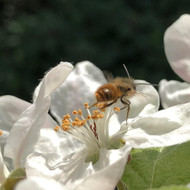We are proud to supply fruit trees to the wonderful Habitat Aid, a company devoted to improving awareness of challenges facing native habitats by both providing practical solutions to gardeners wanting to 'do their bit', and also supporting a whole host of charities who work in the sector. Founder and owner Nick Mann has kindly written a piece for us about the role orchards play in supporting biodiversity, which we share below. Visit their website for a plethora of useful articles on some of the challenges facing the UK's habitats and plants, and how we can all help.
Habitat Aid | Trees & Hedges | Wildflowers | Meadow Seed
One of the earliest descriptions of a mixed orchard here in the UK is John Tradescent’s beautiful early 17th century bound collection of paintings. Vignettes of a menagerie of animals fly, creep and hop their way around the illustrations of the trees in his orchard. There are robins and wrens, goldfinches and thrushes, owls and blackbirds. There are squirrels and snails, frogs and newts. And as for invertebrates, there are earwigs, caterpillars, butterflies and moths, bees, flies, lacewings, ladybirds, dragonflies, spiders, beetles, crickets…
400 years ago we well understood what biodiversity hotspots orchards can be. It’s not very voguish at the moment to point out that three of the best features in our landscape for wildlife aren’t “wild” at all. Wildflower meadows, native hedges and traditional orchards are more or less man-made, but have all been in sharp decline. Perhaps that’s why we’re starting to properly value them again. The People’s Trust For Endangered Species reckon that over 90% of the traditional orchards we had in the 1950s have gone to neglect or development, or been converted to intensive modern orchards.
First off, let’s be clear what a “traditional” orchard is. It can be either mixed – like many domestic sites - or comprised of a single kind of fruit like the cider apple orchards around us in Somerset. They’re planted in low densities as the trees are on much less dwarfing rootstocks than you’d use in an intensive system. It’s obvious that orchards with high biodiversity aren’t sprayed. Even seemingly relatively benign fungicides can form a cocktail of chemicals which have a far from benign effect on pollinators.
Traditional orchards each have their own character. Historically, local varieties of cider apples were grown in Somerset on the vigorous M25 rootstock. These trees are planted at around 8m intervals and grow that high too. Historically this kind of orchard was grazed, as the trees were big enough to accommodate even cattle below their canopy.
An understory like this typically develops into very nice grassland. It will be quite different botanically to an orchard’s margins, which will be more tussocky and unmanaged. Both are potentially excellent for wildlife. It’s no accident that one of the last pockets of the Shrill carder bee, which needs tussocky grass for its nests – is close by the local cider orchards. These tussocky margins support a whole range of other animals, including field voles and related predators like John Tradescent’s owls.
As for the orchard understory itself, it’s undisturbed and “unimproved”. This means that over many years a complex subterranean ecosystem develops. This is perfect for plants like orchids, which depend on mycorrhizal soil fungi. This diverse wildflower community is encouraged too by the lack of fertiliser use. Relatively low levels of nitrogen and phosphates are essential for these species to flourish. They all too often lose the battle against vigorous grasses and plants like nettle, which respond strongly to higher nutrient levels. Staggered grazing or cutting in going to further help floral diversity.
Cider orchards like others are largely pollinated by various kinds of bee – wild bees and honeybees – but their blossom is a boon for a wide range of pollinators. We tend to forget that trees have huge numbers of flowers, and that an orchard with a range of carefully chosen fruit trees can be in flower for nearly four months, from February to medlars in May. This flowering succession is increasingly important to secure a constant flow of pollen and nectar. “Increasingly” as climate change means so many more insects are flying in late winter, desperate for food.
The other obvious food source from an orchard is, of course, fruit. Any fallen fruit is a boon for all sorts of animals in late summer, from butterflies and wasps to birds and mammals. Wasps and parasitic wasps – such helpful insects - also eat fruit earlier in the season. Later, over the winter, we particularly notice thrushes foraging – blackbirds, redwings, fieldfares and song thrushes.
Less obvious are the “pests” which feed on the leaves of orchard trees and fruit as it develops. Larvae and animals like aphids bring with them their own predators, however. Small soldier beetles, lacewings, earwigs and hoverfly and ladybird larvae abound in the orchard canopy. Further up the food chain, tits are voracious predators of aphids and caterpillars too.
Orchards, like woodland and hedges, join up fragmented habitats. The cover they provide allows relatively safe movement for mammals, bats, birds and flying insects. Many of these animals use features like this as navigation aids too. We’re beginning to understand how important this kind of connectivity is in our degraded modern landscape. We can partly compensate for the diminution of habitats in scale and quality by joining up what we have left.
Birds and bats will find lots of nest sites in a traditional orchard too, particularly an older one. Fruit trees have a surprisingly limited life span – typically under 100 years – so if sympathetically managed there’s always going to be a lot of dead wood around. This is fantastic for all sorts of flora and fauna. Standing dead wood and the saproxylic species associated with it, like the rare noble chafer beetle, particularly excite ecologists. Cracks and rot holes shelter mammals, birds and bats too. You’ll find parasitic fauna like mistletoe on old trees too. From the point of view of biodiversity it’s perfect if an orchard has a mix of ages of trees in it, and veterans can still produce good crops of fruit.

